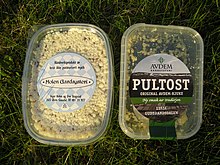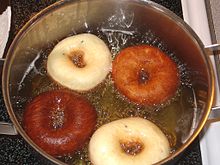
Porridge is a food made by heating or boiling ground, crushed or chopped starchy plants, typically grain, in milk or water. It is often cooked or served with added flavourings such as sugar, honey, fruit, or syrup to make a sweet cereal, or it can be mixed with spices, meat, or vegetables to make a savoury dish. It is usually served hot in a bowl, depending on its consistency. Oat porridge, or oatmeal, is one of the most common types of porridge. Gruel is a thinner version of porridge and congee is a savoury variation of porridge of Asian origin.
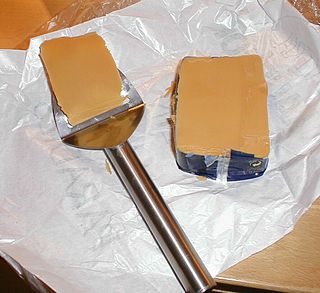
Brunost is a common Norwegian name for mysost, a family of soft cheese-related foods made with whey, milk, and/or cream. The characteristic brown color and sweet taste result from milk sugars being caramelized after boiling. The term brunost is often used to refer to fløtemysost or Gudbrandsdalsost, which are the most popular varieties.

A crêpe or crepe is a dish made from unleavened batter or dough that is cooked on a frying pan or a griddle. Crêpes are usually one of two varieties: sweet crêpes or savoury galettes. They are often served with a wide variety of fillings such as cheese, fruit, vegetables, meats, and a variety of spreads. Crêpes can also be flambéed, such as in crêpes Suzette.

Rice pudding is a dish made from rice mixed with water or milk and commonly other ingredients such as sweeteners, spices, flavourings and sometimes eggs.

Ukrainian cuisine is the collection of the various cooking traditions of the people of Ukraine, one of the largest and most populous European countries. It is heavily influenced by the rich dark soil from which its ingredients come, and often involves many components. Traditional Ukrainian dishes often experience a complex heating process – "at first they are fried or boiled, and then stewed or baked. This is the most distinctive feature of Ukrainian cuisine".

Lefse is a traditional soft Norwegian flatbread. It is made with riced potatoes, can include all purpose (wheat) flour, and includes butter, and milk, cream, or lard. It is cooked on a large, flat griddle. Special tools are used to prepare lefse, including a potato ricer, long wooden turning sticks and special rolling pins with deep grooves.
Norwegian cuisine in its traditional form is based largely on the raw materials readily available in Norway and its mountains, wilderness, and coast. It differs in many respects from continental cuisine through the stronger focus on game and fish. Many of the traditional dishes are the result of using conserved materials, necessary because of the long winters.

Czech cuisine has both influenced and been influenced by the cuisines of surrounding countries and nations. Many of the cakes and pastries that are popular in Central Europe originated within the Czech lands. Contemporary Czech cuisine is more meat-based than in previous periods; the current abundance of farmable meat has enriched its presence in regional cuisine. Traditionally, meat has been reserved for once-weekly consumption, typically on weekends.
Traditional Estonian cuisine has substantially been based on meat and potatoes, and on fish in coastal and lakeside areas, however now bears influences from many other cuisines, including a variety of international foods and dishes, with a number of contributions from the traditions of nearby countries. German, Scandinavian, Russian, Finnish and other influences have played their part. The most typical foods in Estonia have been rye bread, pork, potatoes and dairy products. Estonian eating habits have historically been closely linked to the seasons. In terms of staples, Estonia belongs firmly to the beer, vodka, rye bread and pork "belt" of Europe.

The cuisine of Minnesota is a type of Midwestern cuisine found throughout the state of Minnesota.

A great variety of cassava-based dishes are consumed in the regions where cassava is cultivated.

The traditional cuisine of Abruzzo is eclectic, drawing on pastoral, mountain, and coastal cuisine. Staples of Abruzzo cuisine include bread, pasta, meat, fish, cheese, and wine. The isolation which has characterized the region for centuries has ensured the independence of its culinary tradition from those of nearby regions. Local cuisine was widely appreciated in a 2013 survey among foreign tourists.

Dumpling is a broad class of dishes that consist of pieces of cooked dough, often wrapped around a filling. The dough can be based on bread, wheat or other flours, or potatoes, and it may be filled with meat, fish, tofu, cheese, vegetables, or a combination. Dumplings may be prepared using a variety of cooking methods and are found in many world cuisines.
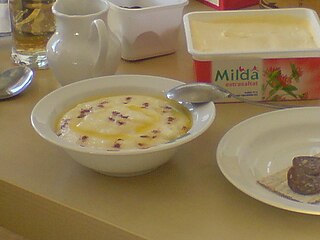
Rømmegrøt, also known as rjomegraut and römmegröt (Swedish), is a Norwegian porridge made with sour cream, whole milk, wheat flour, butter, and salt.
Frisian cuisine consists of the traditional recipes and cooking methods of the historic region of Frisia, which is in present-day Germany and the Netherlands. Frisian cuisine is diverse, drawing from both land and sea. Most dishes, excluding desserts, are made of fish or potatoes, though there are several dishes based on other ingredients. Especially in West Frisia, the food resembles that of the Dutch Cuisine, though East Frisia and North Frisia present dishes that are very much unique to the region.


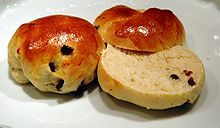




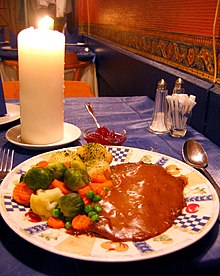







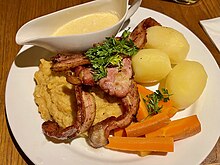





![Persetorsk [no; nn] served with potatoes, vegetables and salad Persetorsk.jpg](http://upload.wikimedia.org/wikipedia/commons/thumb/3/36/Persetorsk.jpg/220px-Persetorsk.jpg)






